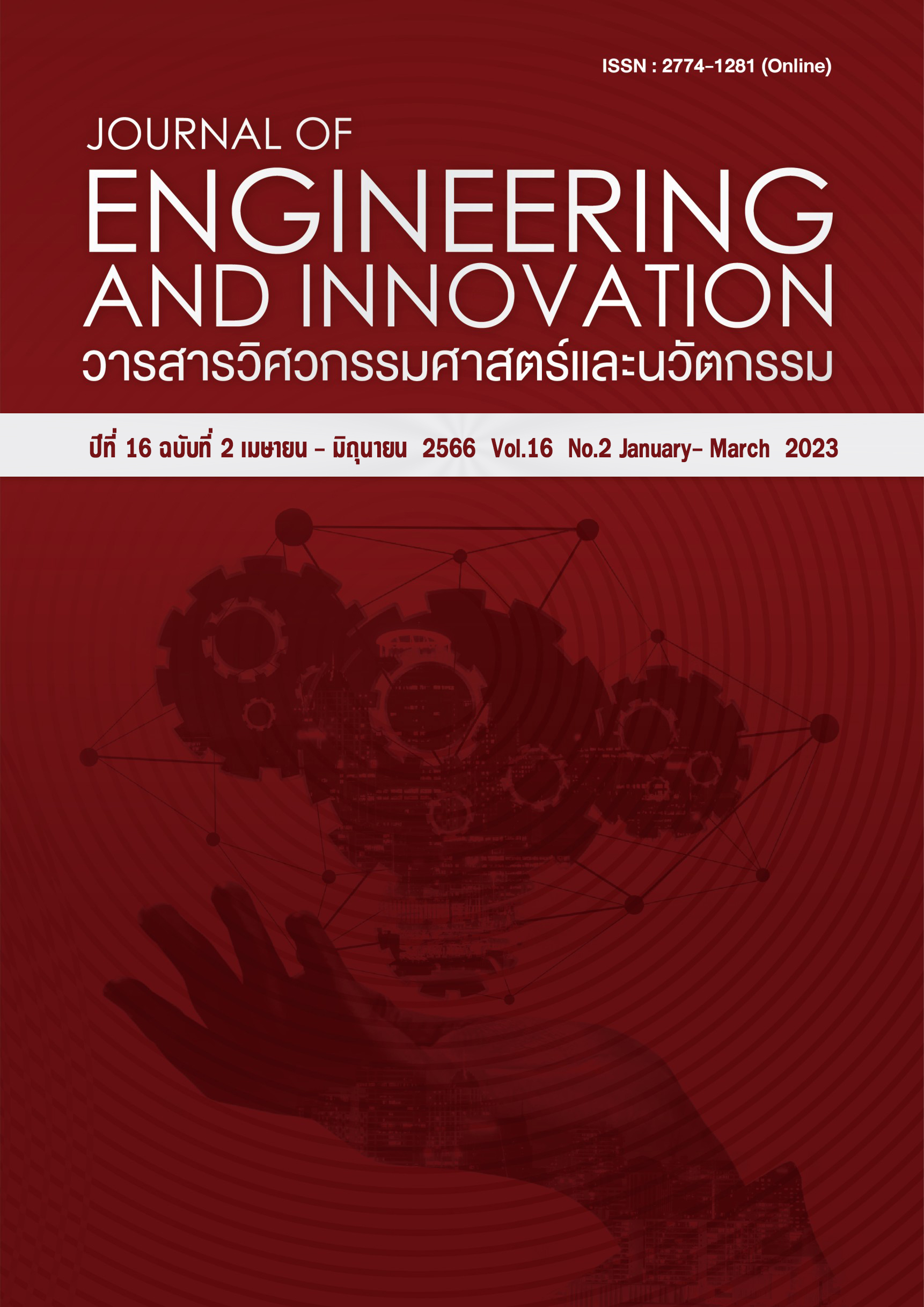Anaerobic Compost Production from Elephant Dung in Combination with Elephant Food Wastes and Fermented Slurry by Biogas recirculation
Main Article Content
Abstract
Elephant camps are the source of massive amounts of waste, mainly from elephant food scraps and dung. These wastes can be used for anaerobic composting to achieve usable waste management goal and reduce greenhouse gas emissions. The objective of this study was 1) to study the appropriate co-fermentation formula based on the characteristics of the compost and 2) to compare the macronutrient value of each formulation of compost with recirculating biogas accumulated in the compost bin with non-recirculating fermentation. The initial carbon to nitrogen ratio (C:N ratio) was varied at 30, 50, and 75 by calculation. The substrates used were fresh elephant dung, Napier grass, Napier grass stems, pineapple leaves, pineapple rhizomes, rice straw, and fermented slurry. This experiment modified the biogas recirculation model with biogas accumulation occurring in the system and no biogas accumulation. The results showed that biogas recirculation and the carbon to nitrogen ratio resulting from different compost materials affect the complete composting characteristics. The products with C:N ratio of 30 NRB and 50 RB are qualified to be organic fertilizer according to the organic fertilizer standard set by the Department of Agriculture. Nitrogen contents were 1.77% and 1.64%wt, phosphorus contents were 1.06 and 0.62% as P2O5, and potassium contents were 4.7 and 2.1%wt for the experimental set at C:N 30 NRB and C:N 50 RB, respectively. Therefore, anaerobic composting from the wastes produced by elephant husbandry is a sustainable development for the community and can lead to zero waste management. In addition, circulating gas back into the system without being released into the atmosphere can help reduce greenhouse gas emissions as well.
Article Details
References
องค์กรพิทักษ์สัตว์แห่งโลก. มาร่วมกันยุติความโหดร้ายที่เกิดขึ้นนี้โดยด่วน. เข้าถึงได้จาก: https://www.worldanimalprotection.or.th/elephant-breeding-ban?utm_source=facebook&utm_medium=social&utm_campaign=th_wine&utm_content=_24_september_2020_0330&fbclid=IwAR2sDq6JH5uu4usJLlFQXL4IoVWIEtwQ8pX-uZvuhTl4IkTVnu0H6b0JdCE. [เข้าถึงเมื่อ วันที่ 14 มีนาคม 2565].
Parajuli AP, Amatya IM, Sharma RK. Effect of feeding rate on the reduction of total volatile solids and organic carbon during combined composting and vermicomposting of elephant dung. Journal of Advanced College of Engineering and Management. 2018; 4: 1-9.
Abdulsalam S, Mohammed J. Production of biogas from cow and elephant dung. Global Journal of Engineering and Technology. 2012; 5(1): 51-56.
Sukasem, N., Khanthi, K. and Prayoonkham, S. 2017. Biomethane recovery from fresh and dry water hyacinth anaerobic co-digestion with pig dung, elephant dung and bat dung with different alkali pretreatments. Energy Procedia 138: 294-300.
Fiala K, Phabjanda M, Maneechom P. Biohydrogen production from xylose by anaerobic mixed cultures in elephant dung. Walailak Journal of Science and Technology. 2014; 12(3): 267-278.
ชล บุนนาค. SDG Move (Moving towards sustainable future. SDG Insights | สถานะประเทศไทยจาก SDG Index: 4 ปีผ่านไป อะไรดีขึ้นหรือแย่ลงบ้าง ?. เข้าถึงได้จาก: https://www.sdgmove.com/2020/02/17/sdg-insights-4years-of-sdgs-in-thailand/ [เข้าถึงเมื่อ วันที่ 1 ธันวาคม 2564].
ธงชัย มาลา. ปุ๋ยอินทรีย์และปุ๋ยชีวภาพ เทคนิคการผลิตและการใช้ประโยชน์. กรุงเทพฯ: ภาควิชาปฐพีวิทยา. คณะเกษตร กำแพงแสน. มหาวิยาลัยเกษตรศาสตร์ วิทยาเขตกำแพงแสน; 2546.
Yang B, Ma Y, Xiong Z. Effects of different composting strategies on methane, nitrous oxide, and carbon dioxide emissions and nutrient loss during small-scale anaerobic composting. Environmental Science and Pollution Research. 2019; 26: 446-455.
Yan S, He Q, Wang W, Li S. CO2 absorption using biogas slurry: CO2 absorption enhancement induced by biomass ash. Energy Procedia. 2017; 114: 890-897.
He Q, Xi J, Wang W, Meng L, Yan S, Zhang, Y. CO2 absorption using biogas slurry: Recovery of absorption performance through CO2 vacuum regeneration. International Journal of Greenhouse Gas Control. 2017; 58: 103-113.
Yan S, Zhang L, Ai P, Wang Y, Zhang Y, Li S. CO2 Absorption by using a low-cost solvent: Biogas slurry produced by anaerobic digestion of biomass. Energy Procedia. 2013; 37: 2172-2179.
Zheng Y, Wang X. Yang F. Improving the anaerobic digestion of switchgrass via cofermentation of rumen microorganisms (rumen bacteria, protozoa, and fungi) and a biogas slurry. Energy & Fuels. 2019; 33: 1185-1195.
กรมพัฒนาที่ดิน. มาตรฐานปุ๋ยอินทรีย์ (ปุ๋ยหมัก ปุ๋ยอินทรีย์คุณภาพสูง. เข้าถึงได้จาก: http://www1.ldd.go.th/ldd/Fertilizer/Organic_Fertilizer.pdf [เข้าถึงเมื่อ วันที่ 24 กรกฎาคม 2564].
Shuiping Y, Liqiang Z, Ping A, Yuanyuan W, Yanlin Z, Shefeng L. CO2 absorption by using a low-cost solvent: biogas slurry produced by anaerobic digestion of biomass. Energy Procedia 2013; 37: 2172-2179.
ทัศนีย์ แก้วมรกรต. การผลิตปุ๋ยหมักจากเศษหอมแดง กระดูกโคเผาป่น และมูลแพะ.วิทยานิพนธ์ วิทยาศาสตรมหาบัณฑิต สาขาวิชาการจัดการทรัพยากรดิน. มหาวิทยาลัยสงขลานครินทร์; 2557.
Lanta elephant sanctuary. The knowledge of elephant dung. Available from: https://lantaelephantsanctuary.com/post/the-knowledge-of-elephant-dung/ [Accessed 25th November 2021]
Meng X, Liu B, Zhang H, Wu J, Yuan X, Cui Z. Co-composting of the biogas residues and spent mushroom substrate: Physicochemical properties and maturity assessment. Bioresource Technology. 2019; 276: 281-287.
Yan S, He Q, Wang W, Li S. CO2 absorption using biogas slurry: CO2 absorption enhancement induced by biomass ash. Energy Procedia. 2017; 114: 890-897.
Wang H, Xu J, Sheng L, Liu X. Effect of addition of biogas slurry for anaerobic fermentation of deer manure on biogas production. Energy 2018; 165: 411-418.

